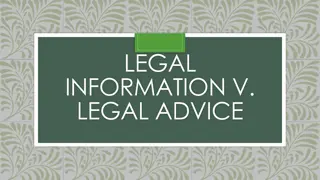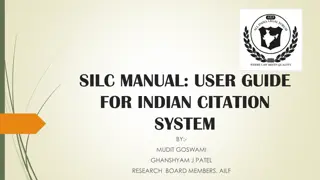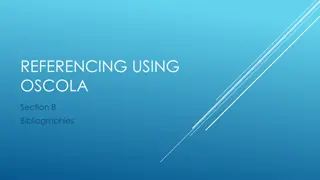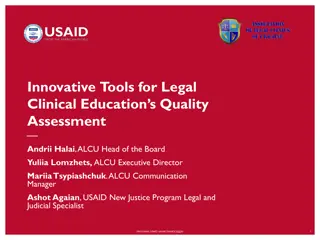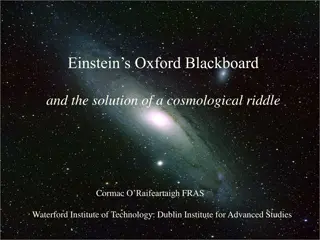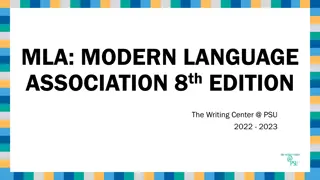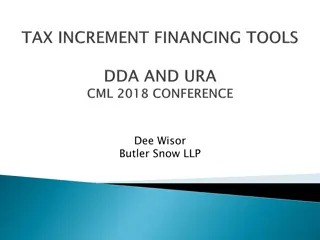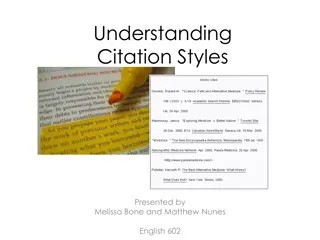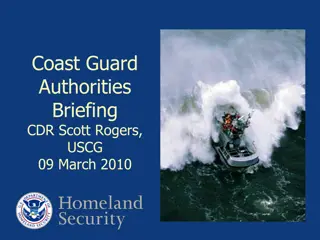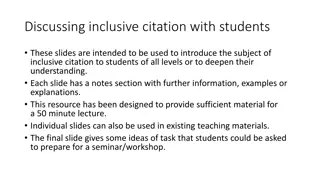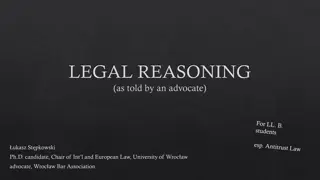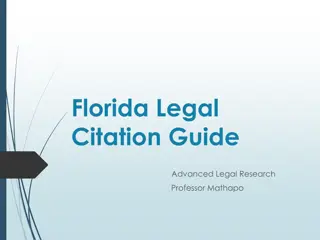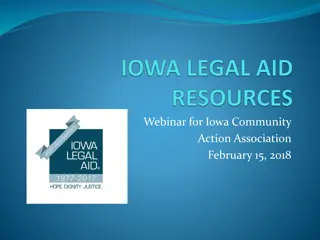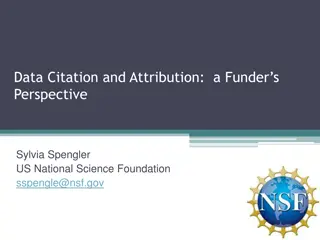The Oxford University Standard for Citation of Legal Authorities (OSCOLA) Overview
OSCOLA is a citation standard designed for legal authorities to enhance consistency and ease of reading. It provides guidelines for citing cases, legislation, and secondary sources, aiming for simplicity and practicality.
Download Presentation

Please find below an Image/Link to download the presentation.
The content on the website is provided AS IS for your information and personal use only. It may not be sold, licensed, or shared on other websites without obtaining consent from the author.If you encounter any issues during the download, it is possible that the publisher has removed the file from their server.
You are allowed to download the files provided on this website for personal or commercial use, subject to the condition that they are used lawfully. All files are the property of their respective owners.
The content on the website is provided AS IS for your information and personal use only. It may not be sold, licensed, or shared on other websites without obtaining consent from the author.
E N D
Presentation Transcript
The Oxford University Standard for Citation of Legal Authorities (OSCOLA) is designed to help the author to achieve consistency and to make life easier for the reader. OSCOLA does not purport to be comprehensive, but gives rules and examples for the main UK legal primary sources, and for many types of secondary sources. As far as possible, the guidelines in OSCOLA are based on common practice in UK legal citation, but with a minimum of punctuation. When citing materials not mentioned in OSCOLA, use the general principles in OSCOLA as a guide, and try to maintain consistency. OSCOLA was first devised by Peter Birks in 2000, in consultation with law students and faculty at Oxford University, and with Oxford University Press and Hart Publishing. It is used by the Oxford University Commonwealth Law Journal, and the editors of that journal have also played an important role in its development. Subsequent editions of OSCOLA were produced in 2002 (by Professor Birks) and in 2004 (revised 2006, both by Timothy Endicott and Sandra Meredith). This latest revision of OSCOLA provides more detailed coverage of domestic legal sources, and in particular the treatment of Welsh, Scottish and Northern Irish sources has been considerably expanded.
CITING CASES When citing cases, give the name of the case, the neutral citation (if appropriate), and volume and first page of the relevant law report, and where necessary the court. If the name of the case is given in the text, it is not necessary to repeat it in the footnote. Phipps v Boardman, and in the earlier Court of Appeal decision in Boulting v Association of Cinematograph, Television and Allied Technicians. In Boulting [or in the Boulting case ] Upjohn LJ said that the rule must be applied realistically to a state of affairs which discloses a real conflict of duty and interest and not to some theoretical or rhetorical conflict . In Phipps, Lord Upjohn developed his view of the rule further by adding that there must be a real sensible possibility of conflict . The relevant footnotes would appear as follows: [1967] 2 AC 46 (HL). [1963] 2 QB 606 (CA). Boulting (n 32) 638. OR ibid 638. Phipps (n 31) 124.
CITING LEGISLATION A citation in a footnote is not required when citing legislation if all the information the reader needs about the source is provided in the text, as in the following sentence: This case highlights the far-reaching judicial role ushered in by the Human Rights Act 1998. Where the text does not include the name of the Act or the relevant section, this information should be provided in a footnote. British courts must only consider Strasbourg jurisprudence: they are not bound by it. Human Rights Act 1998, s 2.
CITING SECONDARY SOURCES If relying on or referring to a secondary source, such as a book or an article, provide a citation for the work in a footnote. Hart wrote that the doctrine of precedent is compatible with two types of creative or legislative activity : distinguishing the earlier case by narrowing the rule extracted from the precedent , and widening the rule by discarding a restriction found in the rule as formulated from the earlier case . The citation will be as follows: HLA Hart, The Concept of Law (2nd edn, Clarendon Press 1994) 135.
CITING CROSS-REFERENCES Cross-references direct the reader to points of substantive discussion elsewhere in your work. Avoid sending the reader off to another part of the text when a short point could as easily be restated. Never make a cross-reference that will be difficult for the reader to find, such as Seeabove . A good cross-reference takes the reader straight to the very place: n 109 or, within the same chapter, text to n 32 . Pagination may change from draft to draft, especially in preparation for publication. It is therefore easiest to cross-refer to footnote markers, for example Text to n 107 in ch 7 . Cross-reference functions in word processors can help you keep track of changes in footnote numbers.
QUOTATIONS Quotations from other works, cases, statutes and so on must be faithful to the original, except where it is necessary to change quotation marks from single to double, or vice versa. Any comments on the quotation, such as emphasis added , should be in a footnote. When a quotation begins in the middle of a sentence in the text, the first letter of the quotation should be capitalized if the quotation itself is a complete sentence, but not otherwise. When intervening text is missing from 9 the quotation, or if it ends mid-sentence in the original text, use an ellipsis ( ) to indicate that some of the original text is missing. Leave a space between an ellipsis and any text or punctuation, except quotation marks. The citation is as follows: The Chief Justice explained that this power is not limited to defence against aggression from a foreign nation . Bix raises the question, What is the point of a dissent, after all, at least on the highest court of the jurisdiction, if the law simply is whatever the majority on that court says it is? Lord Hoffmann reasoned as follows: It seems to me logical to found liability for damages upon the intention of the parties (objectively ascertained) because all contractual liability is voluntarily undertaken. It must be in principle wrong to hold someone liable for risks for which people.
BIBLIOGRAPHIES In longer works, such as theses and books, a bibliography listing secondary sources should be provided after the main body of text and any appendices. It should include all such sources cited in the work and need not be indexed. Items in bibliographies take the same form as all other citations in OSCOLA, with three exceptions: (1) the author s surname should precede his or her initial(s), with no comma separating them, but a comma after the final initial; (2) only initials should be used, and not forenames; and (3) the titles of unattributed works should be preceded by a double em-dash. Works should be arranged in alphabetical order of author surname, with unattributed works being listed at the beginning of the bibliography in alphabetical order of first major word of the title. The Citation will be as: Fisher E, Risk Regulation and Administrative Constitutionalism (Hart Publishing 2007)
LAW REPORT A law report is a published report of a judgment, with additional features such as a headnote summarising the facts of the case and the judgment, catchwords used for indexing, and lists of cases considered. If a case is reported in the Law Reports, this report should generally be cited in preference to any other report. If a judgment is not reported in the Law Reports, cite the Weekly Law Reports or the All England Law Reports. Only if a judgment is not reported in one of these general series should you refer to a specialist series, such as the Lloyd s Law Reports or the Family Law Reports. When citing a case report, put the title of a newspaper in roman, not italics. The example is as under: Taylor v Glass [1979] CLY 672 (CA)
BILLS Cite a Bill by its title, the House in which it originated, the Parliamentary session in brackets, and the running number assigned to it. Running numbers for House of Commons Bills are put in square brackets; those for House of Lords Bills are not. When a Bill is reprinted at any stage it is given a new running number. The bill will have the following components: title | HC Bill | (session) | [number] OR title | HL Bill | (session) | number EXAMPLE: Consolidated Fund HC Bill (2008 09) [5] Academies HL Bill (2010-11) 1, cl 8(2)
JUDGEMENT Give the case registration number in roman and then the name of the case in italics, with no punctuation between them. Give the report citation in the same form as for UK cases. The Citation will have the following components: case number | case name | [year] | report abbreviation | first page EXAMPLE: Case 240/83 Procureur de la R publique v ADBHU [1985] ECR 531
ELECTRONIC SOURCES Citations of publications that are available only electronically should end with the web address (or url ) in angled brackets (< >), followed by the date of most recent access, expressed in the form accessed 1 January 2010 . Include http:// only if the web address does not begin with www . EXAMPLE: <https://www.un.org/en/universal-declaration-human-rights/> (accessed on 21April 2020)
ARTICLES When citing articles, give the author s name first, followed by a comma. Then give the title of the article, in roman within single quotation marks. After the title, give the publication information in the following order: year of publication, in square brackets if it identifies the volume, in round brackets if there is a separate volume number; the volume number if there is one (include an issue number only if the page numbers begin again for each issue within a volume, in which case put the issue number in brackets immediately after the volume number); the name of the journal in roman, in full or abbreviated form, with no full stops; and the first page of the article. EXAMPLE: Paul Craig, Theory, PureTheory and Values in Public Law [2005] PL 440
BOOKS Publication Publication elements should always include the publisher and the year of publication, with a space but no punctuation between them. The place of publication need not be given. If you are citing an edition other than the first edition, indicate that using the form 2nd edn (or rev edn for a revised edition). Additional information should be of a clarifying nature: it may include the editor, the translator or other descriptive information about the work. information follows the title within brackets. EXAMPLE: Gareth Jones, Goff and Jones: The Law of Restitution (1st supp, 7th edn, Sweet & Maxwell 2009)
ENCYCLOPEDIAS Cite an encyclopedia much as you would a book, but excluding the author or editor and publisher and including the edition and year of issue or reissue. Pinpoints to volumes and paragraphs come after the publication information. When an encyclopedia credits an author for a segment, give both the author and the segment title at the beginning of the citation. If citing an online encyclopedia, give the web address and date of access. EXAMPLE: CJ Encyclopedia of the Social Sciences III (1968) 319 Friedrich, Constitutions and Constitutionalism , International
JOURNALS When citing journal articles which have been published only electronically, give publication details as for articles in hard copy journals, but note that online journals may lack some of the publication elements (for example, many do not include page numbers). If citation advice is provided by the online journal, follow it, removing full stops as necessary to comply with OSCOLA. Follow the citation with the web address (in angled brackets) and the date you most recently accessed the article. Pinpoints follow the citation and come before the web address. EXAMPLE: James Boyle, A Manifesto on WIPO and the Future of Intellectual Property 2004 Duke L & Tech Rev 0009 accessed 18 November 2009
LAW COMMISSION REPORTS Cite Law Commission reports by title in italics, Law Com number and year. Do the same with Scottish Law Commission reports, giving the Scot Law Com number. For Law Commission consultation papers and Scottish Law Commission discussion papers, give the Law Com CP number or the Scot Law Com DP number. EXAMPLE: Law Commission, Reforming Bribery (Law Com No 313, 2008) paras 3.12 3.17
THESES When citing an unpublished thesis, give the author, the title and then in brackets the type of thesis, university and year of completion. EXAMPLE: Javan Herberg, Injunctive Relief for Wrongful Termination of Employment (DPhil thesis, University of Oxford 1989)
INTERVIEWS When citing an interview you conducted yourself, give the name, position and institution (as relevant) of the interviewee, and the location and full date of the interview. If the interview was conducted by someone else, the interviewer s name should appear at the beginning of the citation. EXAMPLE: Timothy Endicott and John Gardner, Interview with Tony Honor , Emeritus Regius Professor of Civil Law, University of Oxford (Oxford, 17 July 2007)
PERSONAL COMMUNICATIONS When citing personal communications, such as emails and letters, give the author and recipient of the communication, and the date. If you are yourself the author or recipient of the communication, say fromauthor or toauthor as appropriate. EXAMPLE: Letter from Gordon Brown to Lady Ashton (20 November 2009) Email from Amazon.co.uk to author (16 December 2008)
Follow us ALL INDIA LEGAL FORUM in- https://www.facebook.com/pg/All-India-Legal- Forum-106609507709951/photos/?ref=page_internal allindialegalforum.wordpress.com



